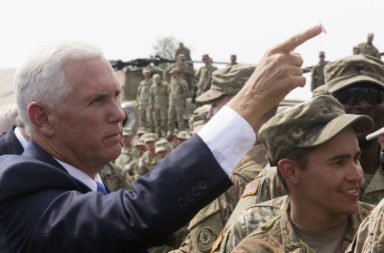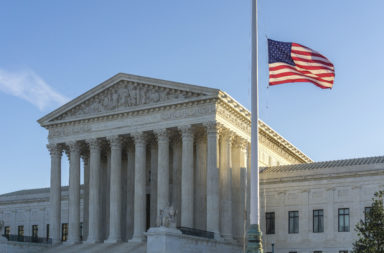Hillary Clinton seems to be running for president because it is her turn. She has paid her dues, and now, it seems, it is her time to run the country.
This perfectly encapsulates the feeling that many, including the candidate herself, surely thought when the race first started: the nomination is almost pre-ordained, because this time there’s no charismatic young senator to steal the show – only an obscure, gray one who embraces an ideology that’s too far from the mainstream of America to catch on.
The opposite was true for Trump. He entered the race with Daily Show host Jon Stewart thanking the comedy gods for bestowing the gift of Trump upon him as he mocked the businessman’s ridiculous entrance to the race and an opening speech that labeled Mexicans “rapists.”
Even after Trump surged in national Republican polls, pundits laughed off his appeal as a summer fling before voters got serious, as happened in 2012 with candidates like Herman Cain and Michele Bachmann.
Then he stayed on top, and then he started winning actual contests, and he began to feel inevitable. But now, like Hillary, that sense of inevitability is fading.
Why?
First, Clinton and Trump face far different problems, and Trump’s are far more serious. But here is a quick sense of Clinton’s issues:
- Her overall favorability ratings are falling even faster than 2008, according to Pew, and are going even more poorly with “independent voters,” (those without an explicit party identification who can often swing elections), according to a Quinnipiac poll.
- Specifically, between August 2007 and April 2008 her overall favorability fell from 55 percent to 49 percent while it fell from 58 percent to 49 percent over the same period this cycle. Her net favorable/unfavorable rating was essentially neutral throughout the entire 2008 cycle among independents, but it’s at negative 27 among independents now.
- Sanders has won eight of the last nine states
- Wisconsin, which Sanders won easily last week, provided excellent exit polling that demonstrates Clinton’s key issues among actual voters shortly after they made their choices
- Sanders crushes Clinton in key respects, including generating excitement, delivering an inspiring message, trustworthiness, and empathy
- 59 percent of Wisconsin voters say Sanders inspires them about the future of the country; 38 percent say the same about Clinton
- Twice as many voters are “excited” about the prospect of a Sanders presidency than about a Clinton presidency
- Critically, about nine in 10 voters say Sanders is honest and trustworthy; only six in 10 say the same about Clinton
- 63 percent of voters prioritized a president who they think “cares about people like me,” and Sanders won these people with 70 percent of the vote
- Only 40 percent of voters prioritize experience and electability, and Clinton dominated those by a large margin
It’s those last two points that are especially worth noting, because they epitomize this particular election, where voters value authenticity – or at least the appearance of authenticity – so much more than experience. But none of the numbers above are good news, particularly her standing with the independent voters she’ll need to win a general election.
And the same truth that has always hurt Clinton still dogs her today: people just don’t get excited about her, which likely has a lot to do with shifting or simply wrong-headed past decisions (read gay marriage, the Iraq War, and criminal justice), the sense that she represents the past, and the idea that she’s just too comfortable among the elites.
The question is whether any of the above keeps her from ultimately getting the nomination. Her delegate lead is about 1,743 to 1,025 when you add her 469 pledged superdelegates – officials who can vote independently at the convention – and the fact that Democratic primaries are so often awarded proportionally. Not to mention the fact that she has considerable leads in New York and Pennsylvania, two major states with diverse populations. It’s also important to keep in mind that she actually has a substantial lead in the actual number of votes cast — to the tune of about 2.4 million, most likely, according to Politifact’s recent count.
Clinton’s strength – pure delegate math – is now Trump’s weakness. More specifically:
- Trump stands at 743 delegates to Ted Cruz’s 545 with 854 remaining, according to the Associated Press. Because the Republican Party threshold to win the nomination outright is 1,237, he needs about 58 percent of the remaining delegates.
- That leaves little room for error, but many upcoming states award their votes proportionally, meaning Cruz and John Kasich could whittle away the lead, and Trump is polling badly in winner-take-all Indiana, which awards a crucial 57 delegates.
- Cruz continues to show a far superior organizational knack, which allowed him to claim all of Colorado’s delegates over the weekend in what is a mind-numbingly complicated caucus process with many layers between what people actually want and which candidate is awarded delegates.
- Trump has fallen from 43 percent support nationally among Republicans in March to 39 percent as of April 10, according to the Real Clear Politics average, a widely used barometer.
- An average of recent polls from the Huffington Post give Trump an average favorability of only 31 percent, which is down from 37 percent as recently as February
Now, Trump will likely regain some ground in New York and other East Coast states that are soon voting, but you can’t argue that he is experiencing an upswing right now. His unscripted, shoot-from-the-hip method may be catching up to him a bit – and at exactly the time when it’s most crucial for him to deliver.
Image Credit: Wikimedia.CC ASA4.0, Link to Photo




